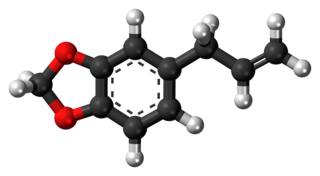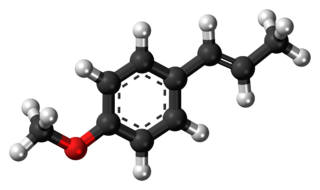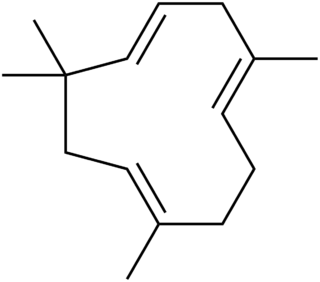
Dill is an annual herb in the celery family Apiaceae. It is the only species in the genus Anethum. Dill is grown widely in Eurasia, where its leaves and seeds are used as a herb or spice for flavouring food.

Thujone is a ketone and a monoterpene that occurs predominantly in two diastereomeric (epimeric) forms: (−)-α-thujone and (+)-β-thujone.

Lavender oil is an essential oil obtained by distillation from the flower spikes of certain species of lavender. There are over 400 types of lavender species worldwide with different scents and qualities. Two forms are distinguished, lavender flower oil, a colorless oil, insoluble in water, having a density of 0.885 g/mL; and lavender spike oil, a distillate from the herb Lavandula latifolia, having density 0.905 g/mL. Like all essential oils, it is not a pure compound; it is a complex mixture of phytochemicals, including linalool and linalyl acetate.

Safrole is an organic compound with the formula CH2O2C6H3CH2CH=CH2. It is a colorless oily liquid, although impure samples can appear yellow. A member of the phenylpropanoid family of natural products, it is found in sassafras plants, among others. Small amounts are found in a wide variety of plants, where it functions as a natural antifeedant. Ocotea pretiosa, which grows in Brazil, and Sassafras albidum, which grows in eastern North America, are the main natural sources of safrole. It has a characteristic "sweet-shop" aroma.

Myristicin is a naturally occurring compound found in common herbs and spices, the most well known being nutmeg. It is an insecticide, and has been shown to enhance the effectiveness of other insecticides in combination. Myristicin is also a precursor for substituted amphetamine derivative compounds structurally related to MMDA and MDMA; it is believed to be metabolized in the liver into MMDA, but unlikely since no MMDA was found in urine, in the body it produce hallucinogenic effects, and can be converted to MMDMA in controlled chemical synthesis. It interacts with many enzymes and signaling pathways in the body, is cytotoxic to living cells, and may also have chemoprotective properties.

Thymol, C10H14O, is a natural monoterpenoid phenol derivative of p-Cymene, isomeric with carvacrol, found in oil of thyme, and extracted from Thymus vulgaris, ajwain, and various other plants as a white crystalline substance of a pleasant aromatic odor and strong antiseptic properties. Thymol also provides the distinctive, strong flavor of the culinary herb thyme, also produced from T. vulgaris.

Eugenol is an allyl chain-substituted guaiacol, a member of the allylbenzene class of chemical compounds. It is a colorless to pale yellow, aromatic oily liquid extracted from certain essential oils especially from clove, nutmeg, cinnamon, basil and bay leaf. It is present in concentrations of 80–90% in clove bud oil and at 82–88% in clove leaf oil. Eugenol has a pleasant, spicy, clove-like scent. The name is derived from Eugenia caryophyllata, the former Linnean nomenclature term for cloves. The currently accepted name is Syzygium aromaticum.

Anethole is an organic compound that is widely used as a flavoring substance. It is a derivative of phenylpropene, a type of aromatic compound that occurs widely in nature, in essential oils. It is in the class of phenylpropanoid organic compounds. It contributes a large component of the odor and flavor of anise and fennel, anise myrtle (Myrtaceae), liquorice (Fabaceae), magnolia blossoms, and star anise (Schisandraceae). Closely related to anethole is its isomer estragole, abundant in tarragon (Asteraceae) and basil (Lamiaceae), that has a flavor reminiscent of anise. It is a colorless, fragrant, mildly volatile liquid. Anethole is only slightly soluble in water but exhibits high solubility in ethanol. This trait causes certain anise-flavored liqueurs to become opaque when diluted with water, the ouzo effect.

Carvone is a member of a family of chemicals called terpenoids. Carvone is found naturally in many essential oils, but is most abundant in the oils from seeds of caraway, spearmint, and dill.

Apiole is a phenylpropene, also known as apiol, parsley apiol, or parsley camphor. Its chemical name is 1-allyl-2,5-dimethoxy-3,4-methylenedioxybenzene. It is found in the essential oils of celery leaf and all parts of parsley. Heinrich Christoph Link, an apothecary in Leipzig, discovered the substance in 1715 as greenish crystals reduced by steam from oil of parsley. In 1855 Joret and Homolle discovered that apiol was an effective treatment of amenorrea or lack of menstruation.

Eucalyptol is a monoterpenoid. A colorless liquid, it is a bicyclic ether. Eucalyptol has a fresh mint-like smell and a spicy, cooling taste. It is insoluble in water, but miscible with organic solvents. Eucalyptol makes up 90% of eucalyptus oil. Eucalyptol forms crystalline adducts with hydrohalic acids, o-cresol, resorcinol, and phosphoric acid. Formation of these adducts is useful for purification.

Caryophyllene, more formally (−)-β-caryophyllene, (BCP), is a natural bicyclic sesquiterpene that is a constituent of many essential oils, especially clove oil, the oil from the stems and flowers of Syzygium aromaticum (cloves), the essential oil of Cannabis sativa, rosemary, and hops. It is usually found as a mixture with isocaryophyllene and α-humulene, a ring-opened isomer. Caryophyllene is notable for having a cyclobutane ring, as well as a trans-double bond in a 9-membered ring, both rarities in nature.

Humulene, also known as α-humulene or α-caryophyllene, is a naturally occurring monocyclic sesquiterpene (C15H24), containing an 11-membered ring and consisting of 3 isoprene units containing three nonconjugated C=C double bonds, two of them being triply substituted and one being doubly substituted. It was first found in the essential oils of Humulus lupulus (hops), from which it derives its name. Humulene is an isomer of β-caryophyllene, and the two are often found together as a mixture in many aromatic plants.

α-Pinene is an organic compound of the terpene class, one of two isomers of pinene. It is an alkene and it contains a reactive four-membered ring. It is found in the oils of many species of many coniferous trees, notably the pine. It is also found in the essential oil of rosemary and Satureja myrtifolia. Both enantiomers are known in nature; (1S,5S)- or (−)-α-pinene is more common in European pines, whereas the (1R,5R)- or (+)-α-isomer is more common in North America. The racemic mixture is present in some oils such as eucalyptus oil and orange peel oil.

The phenylpropanoids are a diverse family of organic compounds that are synthesized by plants from the amino acids phenylalanine and tyrosine. Their name is derived from the six-carbon, aromatic phenyl group and the three-carbon propene tail of coumaric acid, which is the central intermediate in phenylpropanoid biosynthesis. From 4-coumaroyl-CoA emanates the biosynthesis of myriad natural products including lignols, flavonoids, isoflavonoids, coumarins, aurones, stilbenes, catechin, and phenylpropanoids. The coumaroyl component is produced from cinnamic acid.

2,5-Dimethoxy-3,4-methylenedioxyamphetamine (DMMDA) is a psychedelic drug of the phenethylamine and amphetamine chemical classes. It was first synthesized by Alexander Shulgin and was described in his book PiHKAL. Shulgin listed the dosage as 30–75 mg and the duration as 6–8 hours. He reported DMMDA as producing LSD-like images, mydriasis, ataxia, and time dilation.

α-Cadinol or 10α-hydroxy-4-cadinene is an organic compound, a sesquiterpenoid alcohol.

Nothoapiole is a phenylpropene, a natural organic compound present in the essential oil of Perilla frutescens from Jeju Island in Korea and the major component of the essential oil obtained from the roots of Pleurospermum angelicoides Benth. It is also found in the essential oil of black caraway fruits and Carum nigrum.

Bornyl acetate is a chemical compound. Its molecular formula is C12H20O2 and its molecular weight is 196.29 g/mol. It is the acetate ester of borneol. It is used as a food additive, flavouring agent, and odour agent.




















